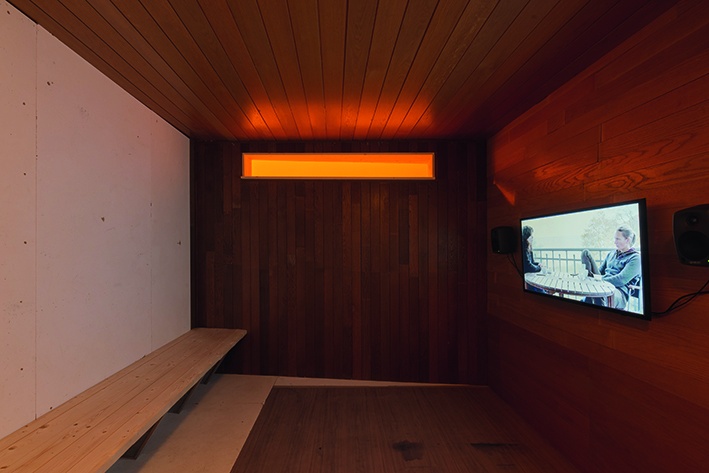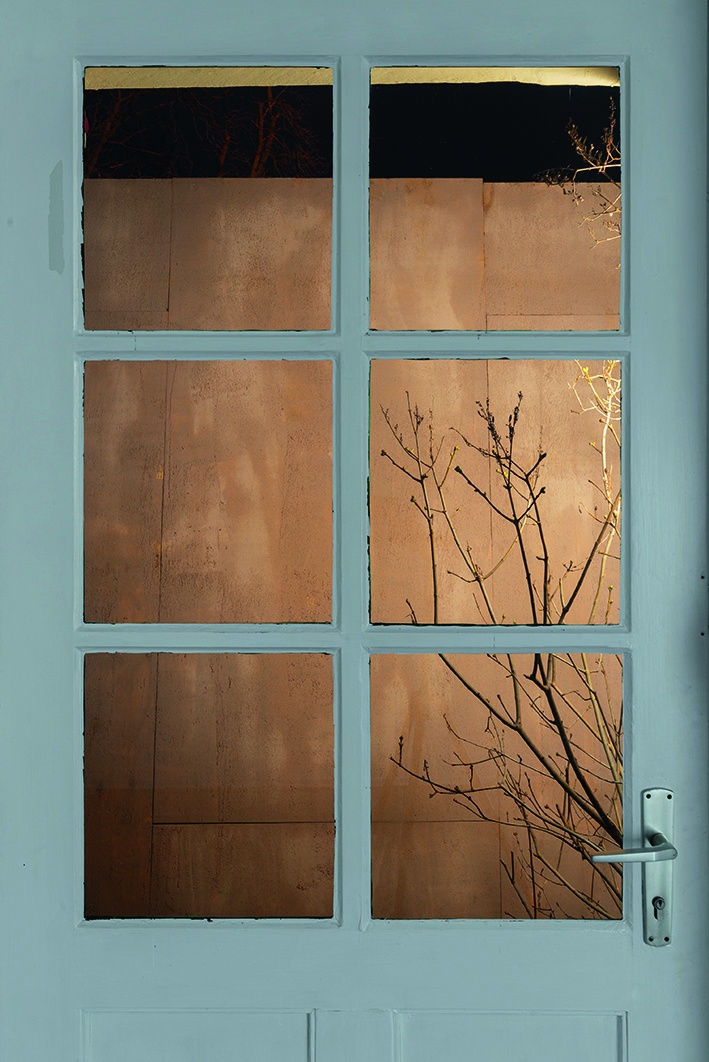Making Metaphors Useful Ben Caton on Richard Sides at the Kunstverein Braunschweig

“Richard Sides: Dwelling,” Kunstverein Braunschweig, 2019–2020, installation view
Built in 1808 as a private residence and sold to the city in 1927, Braunschweig’s classical Villa Salve Hospes is today home to the city’s Kunstverein. The villa is flanked by a smaller exhibition space, the Remise, and is situated on the edge of a garden bordering a public park, all of which were designed along with the villa itself by the same architect. While situated on private property, these gardens were nonetheless originally open to all and served as the center of local public life in the 19th century – “common” land. It is in these picturesque surroundings that visitors to Richard Sides’s exhibition “Dwelling” find its first element: a concrete-like structure that resembles a partition wall and blocks entry to the Remise from the gardens. Entering instead via the front and viewing the sculpture from inside, it creates the impression of a small courtyard or alley. Also presented in this room is a flat-screen monitor furnished with an architectural model that covers its screen and makes it appear as if a video is being projected out of sight at the end of a long passageway. Across the hall, the second room houses an architectural installation made up of two elements: an industrial-looking black beam spanning floor and ceiling (the press release describes this as a folly, a “purposeless, immersive decoration”) and a small, makeshift structure reminiscent of a hut, seemingly cobbled together from found materials but with a sort of austere stylishness to it reminiscent of a tiny house inhabited by a YouTube ultra-minimalist: a wooden cabin containing nothing more than a round mirror on its wall and a video installation with a bench for seating. This, then, is the “place for habitation” also described in the press release.
The word “folly” describes both a purposeless building and an ill-advised venture, and so given Sides’s connection to London (where many new “residential” buildings can be described in both terms) and the visual pun of the dead end provided by the wall sculpture, it seems at first as if the target of the exhibition might be the idea that “downsizing” could offer some way out of the precarious living situations suffered by so many today in the UK and beyond. This is then partly confirmed by the film’s early scenes, which see a young man (played by Sides himself) waking in the middle of the night to a phone call from a clearly distressed friend named Peter, rambling on about how he has been “catfished.” The two meet in a cafe, and Peter embarks on a paranoid and barely comprehensible rant, talking of going “off-grid” and retreating to a “parasite pod” (a micro-living space designed to be attached to an existing building), complaining of neo-fascists and eco-fears and referring to a figure called Mark who “introduced us to a sort of vicarious telepathy” after “we all stopped talking to each other.” He also describes a dream of waking up confused in a 500-meter-high Plattenbau: the Tower of Babel reimagined as a series of boxy apartments? But for all his agitation, his attitude is clearly ambivalent, as he also talks of the relief felt in abandoning oneself as a channel for passive communication, and of the benefits of quasi-spiritual digital doctrines such as dopamine fasting. Sides’s character’s attempts to understand what his friend is saying are met with only resentment and accusations of “not listening,” and following an angry confrontation, Peter burns a set of A4 print-outs containing his personal data on the street before retreating to a cardboard box. Housing not as housing, then, but as an expression of the anxieties of our digital era, our wish to simultaneously live in a globalized and networked world while also retreating from all of the precarity and paranoia this brings with it. Or perhaps a metaphor for the temptation for artists to retreat into their practice in times that seem to offer little hope for meaningful change? After all, wealthy Europeans once built follies on their grounds as homes for hermits, a retreat from the “real” world meant to symbolize their own intellect as landowners – are things really so different today?

“Richard Sides: Dwelling,” Kunstverein Braunschweig, 2019–2020, installation view
Then, around a third of the way in, the film takes a narrative turn: another phone call, this time between two women. Mirroring Peter’s rant earlier on, one of them describes a dream that likewise nods to the existential angst that comes with life in the algorithm: of tinnitus generated in sync with one’s own heartbeat, white noise from within that hinders communication, and a growing feeling of inner decay. The two then meet and continue their conversation in person, in and around what appears to be a beachside apartment in a northern German resort. The remainder of the film is given over to their time together on this retreat, as they discuss life’s great challenges of grief and death, muse on the nature of oneness, and swap gruesome stories from their hometowns. If the film’s first section could be read as an exaggeration of the problems men can sometimes have communicating with each other, this second one champions the power of talking as an active process of both listening and being heard. The women’s conversation shifts between ideas of commonality, the passing of time (and fleetingness of life), and our seeming inability to step outside of ourselves and live in the moment. They also raise the issue of identity politics and the problems it brings for those on the left; just as the film’s first act (and the image of the Plattenbau-Babel in particular) seems to imply that any technology that aims to bring us together while simultaneously placing us in ever-tighter categories is in reality by its very nature inherently divisive, the women’s conversation suggests that repeating this logic in any political movement based on a principle of unity is equally absurd. Their repeated emphasis is on the idea that it is in shared experience that commonality is to be found. In this context, then, the exhibition’s title could well be interpreted as referring to the moments we inhabit in our lives, rather than the spaces we live in.
And so where the interaction between the two men posits physical retreat as a defensive response against an online environment where communication has become toxically divisive, that between the two women presents experience (both shared and individual) as something that should be defended against metaphors of ownership. Taken as a comment on the problems the internet has so far brought with it, this would seem clear enough, but there is another, much more literal element to the metaphor of digital angst symbolized by Peter’s retreat to his box, one that gets to the heart of a central paradox in the digital dream: the bald reality that for all of the internet’s promise of limitless expansion, it doesn’t offer any real solutions to the fundamental issue of supporting a growing population on a planet with finite resources, both environmental and otherwise. This question was famously addressed in Garret Hardin’s 1968 essay “The Tragedy of the Commons,” which saw all common property as doomed to overexploitation due to innate human selfishness (using the example of overfarmed land). His proposed solution was a somewhat different take on downsizing: privatize all property, abolish human rights, control reproduction, and let social Darwinism do the rest. A glimpse of an eco-fascist future to come, perhaps? Certainly, it remains to be seen to what extent the environmental cause will remain largely aligned with the Left, as recently demonstrated by Austria’s Greens taking the place of the far-right FPÖ in the ruling coalition with the right-wing ÖVP. Similarly, the question also remains open of whether and to what extent the Left will be able to incorporate ideas from the green movement into itself, or whether it will instead have to be built anew from the ground up, so to speak. And so it seems fair to say that the sort of ideas of social and spatial justice associated with the historical Left currently face a somewhat uncertain future. And yet many would argue that a Left understanding of the problem of property is essential to tackling the climate crisis, this show included; here, the tragedy of common land clearly lies in the moment of its original appropriation, rather than in the inevitability of its overexploitation. What does seem certain is that if there is to be any real chance of long-term survival (of the Left, the planet, and ourselves), it will involve finding common ground under extremely challenging conditions while still somehow actively opposing the forces of fascism. In this light, then, and at a time when some on the left (in the UK especially) seem to be more focused on identifying “false friends” than anything else, this exhibition’s implicit message – that understanding is every bit as vital (in both senses) as anger – feels both highly prescient and strangely radical.
“Richard Sides: Dwelling,” Kunstverein Braunschweig, December 7, 2019–February 16, 2020.
